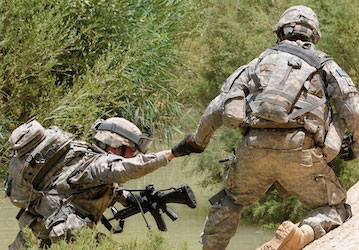When you understand cohesion, you can build stronger relationships with the members of your unit. Social cohesion—the nature of the bonds between team members—is a measure of military performance, combat motivation, and social support. Learning facts about social cohesion can help you build a stronger team.
Fact: A cohesive team can be made up of individuals with different backgrounds, experiences, and knowledge.
Some people think everyone on a team needs to be similar to achieve cohesion. But you don’t have to be exactly like your unit members to achieve cohesion. In fact, sharing varied perspectives and making the most of different talents can improve your ability to solve problems and help make your team even stronger.
Fact: Cohesion is healthy for Service Members.
Individuals in units with strong cohesion before deployment have a lower risk of developing post-deployment PTSD, depression, anxiety, distress, alcohol abuse, and negative mental health. Strong cohesion is also related to higher levels of resilience, management of stress, and overall positive states of mind.
Fact: Trust is an important building block of cohesion.
Knowing that you can count on your teammates can help you feel connected to the team. Trust also means you believe your teammates are not only focused on the task at hand, but they are competent enough to help you complete it.
Fact: Cohesion can be built intentionally.
Cohesion takes shape when you actively engage in meaningful communication and make the most of opportunities to build trust. Just as with close personal relationships, it takes intentional effort to create the genuine connections that can help your unit function effectively. Read on to learn more about how to build cohesion intentionally.
Here are some more things you can focus on to build stronger cohesion in your unit:
- Mutual support. Social support—the care you give to or get from others—comes in many different forms. Whether it’s helping a friend, taking care of things at home, or watching a fellow Service Member’s back, social support is a key element to increase cohesion and strengthen bonds in all kinds of settings.
- Cooperation. Trust and choice are basic elements that help a group work together smoothly and optimize cooperation. A cohesive unit is made up of members who communicate effectively, overcome conflict, and work together willingly.
- Shared commitment. In a cohesive group, members are both committed to one another and collectively committed to a task, mission, or cause. Whether it means building close one-on-one relationships or recognizing every team member is crucial to unit success, cohesion is all about interdependence and shared goals.
Social and team cohesion are important factors to optimize your well-being and performance. Think about how cohesive your team and unit are, as well as how connected you feel to those around you. The more supportive, cooperative, and committed you are to your unit members and your work, the stronger you and your team can be. To learn more about team cohesion, read HPRC’s article about how to build an effective team.
HPRC’s #GotMySix campaign encourages you to think about your connection to others and how their support makes a difference in your life. Join the campaign by posting a message on social media about the support and cohesion within your team or unit, and include #GotMySix in your post.





